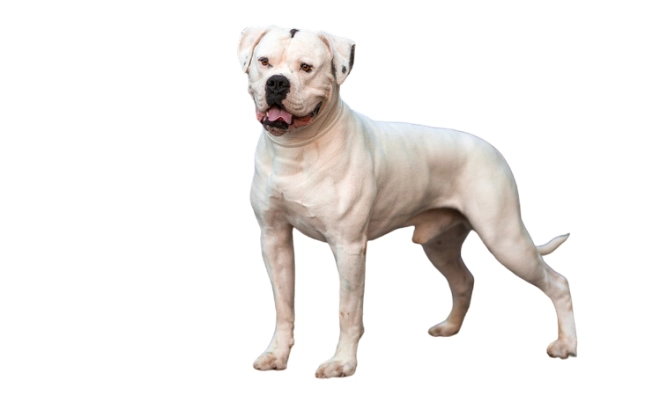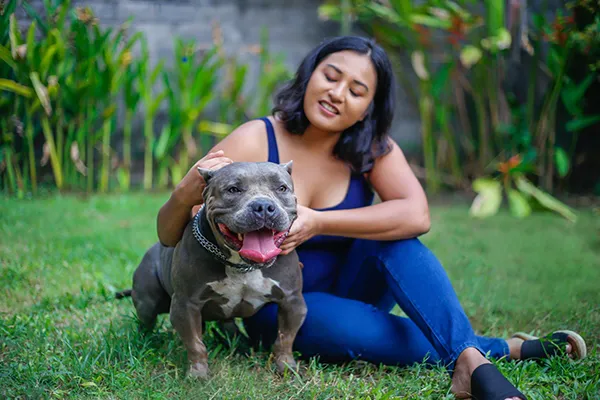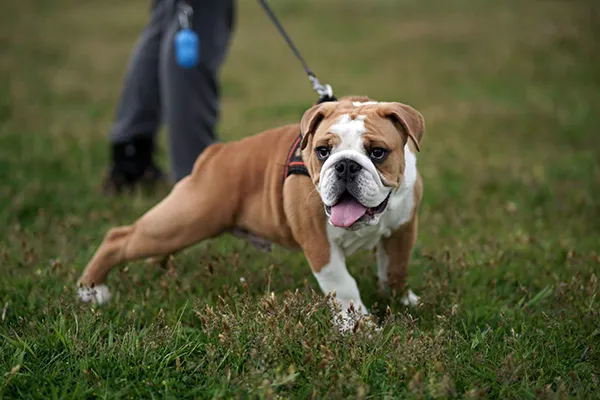
The American Bulldog, a breed renowned for its remarkable blend of strength, loyalty, and affable temperament, has a captivating history that traces its lineage back to the English Bulldog. This breed found its way to the United States as early as the 17th century and played a crucial role on farms and ranches, serving as farm guardians, stock dogs, and catch dogs. This article delves into the fascinating journey of the American Bulldog, uncovering its historical significance, unique physical characteristics, and the distinctive bond it forges with families. From their muscular build to their unwavering dedication, this breed has left an indelible mark in the hearts of dog enthusiasts. Join us as we explore the multifaceted world of the American Bulldog and discover what makes them such beloved and valued companions.
About the Breed
The American Bulldog, a remarkable breed known for its athletic abilities, strength, and friendly nature. This dog has a history that goes way back. It’s actually a descendant of the English Bulldog and arrived in America around the 17th century. Immigrants brought their bulldogs to the United States in the 1800s. On farms, these dogs were like all-in-one workers, guarding the farm, herding livestock, and even helping catch unruly animals like feral pigs.
Before becoming the American Bulldog we know today, this breed had different names depending on where you were. In the South, it was sometimes called the White English Southern Bulldog, but mostly folks just called it “bulldog.” And interestingly, it wasn’t named for its looks but because of the tough jobs it could handle. This dog has a real legacy of hard work and toughness in American history.
Breed Overview
| Aspect | Description |
| Origin | Descendant of the English Bulldog; Originated in the United States |
| Group | Foundation Stock Service |
| Height | 22 to 25 inches (males); 20 to 23 inches (females) |
| Weight | 75 to 100 pounds (males); 60 to 80 pounds (females) |
| Coat | Smooth, short coat |
| Coat Color | Typically white with patches of brindle, red, black, brown, or gray |
| Life Span | 10 to 12 years |
| Temperament | Friendly, loyal, playful, protective, confident |
| Hypoallergenic | No |
Characteristics of the American Bulldog
American Bulldogs thrive when they are in the care of experienced owners who can invest the time and effort required for training and exercise. Given their protective nature, socialization during their puppyhood is crucial to ensure that they are comfortable around strangers, other dogs, and even cats. Positive reinforcement training techniques work wonders with this breed, encouraging their natural friendliness to shine when interacting with new people. Once familiar with individuals, American Bulldogs often display an especially affectionate temperament.
Regular exercise is a must for these robust dogs to keep boredom at bay and prevent any undesirable behavior at home. They relish brisk walks with their owners and are known for their enthusiastic personalities, making them excellent playmates for both adults and children.
| Affection Level | Level High |
| Pet-Friendly | Medium |
| Intelligence | Medium |
| Friendliness | High |
| Kid-Friendly | High |
| Exercise Needs | High |
| Playfulness | High |
| Energy Level | Medium |
| Trainability | Medium |
| Tendency to Bark | Medium |
| Amount of Shedding | Low |
History of the American Bulldog

The history of American Bulldogs is closely intertwined with their English Bulldog ancestors. Originally, English Bulldogs were bred for the brutal sport of bull baiting in 17th century England, a practice that has long been abolished. Over time, they transitioned from the bullring to become beloved family pets and even a national symbol in England.
When English Bulldogs made their way to North America, their strength and determination found a new purpose as farm dogs. Farmers selectively bred them with other working dogs to create the ideal all-around breed for various tasks. Their intelligence, loyalty, and agility made them valuable assets for herding and hunting.
During WWI and WWII, the American Bulldog breed faced a significant decline in population. Thanks to the dedication of two breeders, John D. Johnson and Alan Scott, these dogs were successfully repopulated and emerged as the popular companions they are today.
As the breed evolved, American Bulldogs became renowned for their friendliness and became a staple in North American families. Their imposing appearance and physical strength also made them an ideal choice to represent competitive sports teams.
Recognition from the United Kennel Club in 1999 and inclusion in the AKC’s Foundation Stock Service in 2019 marked significant milestones in the breed’s journey, solidifying their status as a distinct and valued breed in the world of canine companions.
American Bulldog Care

The American Bulldog is an excellent choice for a family pet, but their well-being hinges on significant exercise and proper training to ensure they grow into a healthy, well-mannered companion. When it comes to grooming, their short, low-maintenance coat is a breeze to care for.
Exercise
American Bulldogs thrive when they get at least an hour of exercise each day. Owners can meet this requirement through daily walks or playtime in the yard. Regular exercise not only helps maintain your dog’s health and weight but also keeps them mentally engaged.
Without sufficient exercise, American Bulldogs may resort to creating their entertainment, which can lead to unwanted behaviors like chewing on furniture or exploring off-limits areas in your home. This breed is ideally suited for active families who relish playtime with their furry companions. Whether it’s going for walks, runs, hikes, or playing games like fetch or tug-of-war, your American Bulldog will enthusiastically join in the fun.
Grooming
The American Bulldog’s grooming needs are relatively minimal due to their short and fine coat, but it’s important to note that this breed sheds year-round. The good news is that these dogs typically enjoy grooming, and weekly brushing proves highly effective in managing shedding.
However, it’s essential to be aware of their tendency to drool, which is perfectly natural. To prevent the buildup of bacteria or infections, it’s important to keep their facial wrinkles free from excess moisture. In addition to brushing, regular baths, nail trimming, and ear cleaning are vital aspects of their care. To avoid overgrowth and discomfort, their nails should be trimmed every few weeks. Likewise, keeping their ears clean is necessary to prevent infections, although the frequency may vary based on individual needs.
Training

For the American Bulldog, consistent training is an absolute must. These dogs have a natural protective instinct, which can sometimes be a bit too intense, but they are also eager learners. Basic obedience training can commence as early as six to eight weeks of age, and socialization is crucial once your puppy has received the necessary vaccines to safely interact with the public.
American Bulldogs may require guidance to exhibit appropriate behavior around strangers and other animals. This not only ensures they become friendly companions but also helps prevent any unnecessary aggression. Given their penchant for love and attention from their owners, positive reinforcement techniques, like treats, affection, and playtime, work wonders in encouraging desirable behavior. Training should be a consistent and ongoing practice throughout your dog’s life, resulting in a well-adjusted and friendly American Bulldog.
Common Health Problems
It’s important to be aware that, like many purebred dogs, American Bulldogs can be susceptible to certain genetic health issues. Responsible breeders take proactive measures by testing prospective parent dogs before breeding to minimize the risk of passing these problems down to their puppies. Here are some conditions to keep in mind when it comes to this breed:
- Elbow and Hip Dysplasia: These joint issues are relatively common in larger dog breeds, including the American Bulldog. Dysplasia occurs as the dog ages due to a malformation in the joints, which can lead to discomfort and mobility problems.
- Neuronal Ceroid Lipofuscinosis: This hereditary disorder impacts the dog’s central nervous system and can be detected through genetic testing. It’s essential for breeders to be aware of this condition within specific bloodlines to prevent its occurrence in puppies.
- Allergies: American Bulldogs can develop allergies, often associated with an overactive immune system. While some puppies may outgrow these allergies, they can persist into adulthood. Symptoms may include redness, itchy skin, or excessive licking of paws. If your dog exhibits these signs, consult with your veterinarian, who may recommend a food allergy test to identify specific triggers and help manage the condition effectively.
Diet and Nutrition
Proper nutrition is vital for the well-being of your American Bulldog. To keep them healthy and thriving, consider the following points:
- High-Quality Dog Food: Opt for high-quality dog food where meat protein is listed as the first ingredient. This ensures that your American Bulldog gets the essential nutrients they need to maintain their health.
- Avoid Overfeeding: Overfeeding can lead to unnecessary weight gain, which, in turn, can cause joint issues. Be mindful of portion sizes and resist the urge to overindulge your furry companion.
- Joint Health: Consult your veterinarian, who may recommend incorporating omega-3 fatty acids into your dog’s diet. These supplements can promote joint health, particularly important for a breed like the American Bulldog.
- Food Allergies: If your dog exhibits symptoms like red, itchy skin, consider the possibility of food allergies. Consult your veterinarian to determine a suitable diet that addresses these issues. Portion sizes should be tailored to your dog’s age, weight, activity level, and any specific medical needs. While allergy tests provide the most definitive results, you can also gradually switch between different protein options to discover what suits your dog best.
Maintaining a well-balanced and tailored diet is key to ensuring your American Bulldog’s long-term health and happiness.
Where to Adopt or Buy an American Bulldog
For those considering bringing an American Bulldog into their lives, finding the right furry companion is an exciting journey. Here are some points to keep in mind when looking to adopt or purchase an American Bulldog:
- Adoption: American Bulldogs are a popular breed in many regions of the United States, making it relatively easy to find them in need of loving homes. Local animal shelters and rescue organizations are excellent places to start your search. These dogs are often available for adoption, providing a second chance to a dog in need of a forever family. Additionally, breed-specific rescue groups are dedicated to the welfare of American Bulldogs, offering a variety of dogs to choose from.
- Responsible Breeding: If you’re set on adopting a puppy, it’s crucial to research and select a responsible breeder. Ensure that the breeder provides a health guarantee for the puppy and shares the family medical history of the litter. A reputable breeder should also allow you to meet the puppy’s parents and provide an opportunity to see the living conditions in which their dogs are raised.
For a more guided search, consider exploring these valuable resources:
American Bulldog Rescue: Dedicated to finding homes for American Bulldogs in need.
American Bulldog Association: Offers information on breed standards and responsible breeding practices.
AKC American Bulldog Breeders: Provides a list of breeders who adhere to AKC standards and regulations.
Whether you decide to adopt or purchase, embarking on this journey with the right knowledge and resources will help you find the perfect American Bulldog companion for your family.
American Bulldog Pros & Cons
Pros:
1. Friendly Companions: American Bulldogs are known for their friendly and loving nature, making them wonderful companions for both children and adults. Their protective instincts often lead to strong bonds with their families.
2. Ideal for Active Owners: If you’re an active individual or family who enjoys outdoor activities and playtime, the American Bulldog will be a perfect fit. They thrive on exercise and interaction, making them great partners for an active lifestyle.
3. Low-Maintenance Coat: These dogs sport a short, low-maintenance coat, reducing the grooming demands and keeping care relatively straightforward.
Cons:
1. Prone to Drooling: One notable downside is their tendency to drool. While this is a natural trait, it’s essential to manage and keep their facial wrinkles dry to prevent any potential issues like bacterial buildup or infections.
2. Specialized Diet: American Bulldogs may, at times, require a specialized diet, especially if they have food allergies. Discuss dietary requirements and any potential allergies with your veterinarian to ensure your dog’s nutritional needs are met.
3. Need for Exercise and Socialization: To be well-mannered and happy, American Bulldogs require significant exercise and socialization. Without these, they may exhibit unwanted behaviors. Active families who enjoy outdoor activities and can commit to training and socializing their dogs will find this breed to be a rewarding companion.
FAQ
Q1: Is an American Bulldog a Pit Bull?
While the two breeds may look alike in many ways, the American Bulldog is not the same as an American Pit Bull Terrier (APBT). American Bulldogs are much larger, and the APBT can have more varieties in coat color. Both breeds have a similar temperament, exercise needs, and socialization requirements to become well-mannered pets.
Q2: Is an American Bulldog a Good Family Dog?
If its owners provide the proper training and socialization, American Bulldogs can become great family pets. This breed needs plenty of exercise to stay healthy, but with the right care, American Bulldogs are known for being especially loving and protective of their families.
Q3: Do American Bulldogs Bark a Lot?
American Bulldogs aren’t as prone to barking as some dogs that were bred to alert, but they can still become vocal. Thankfully, there are plenty of ways to train your dog that discourage excessive barking.



